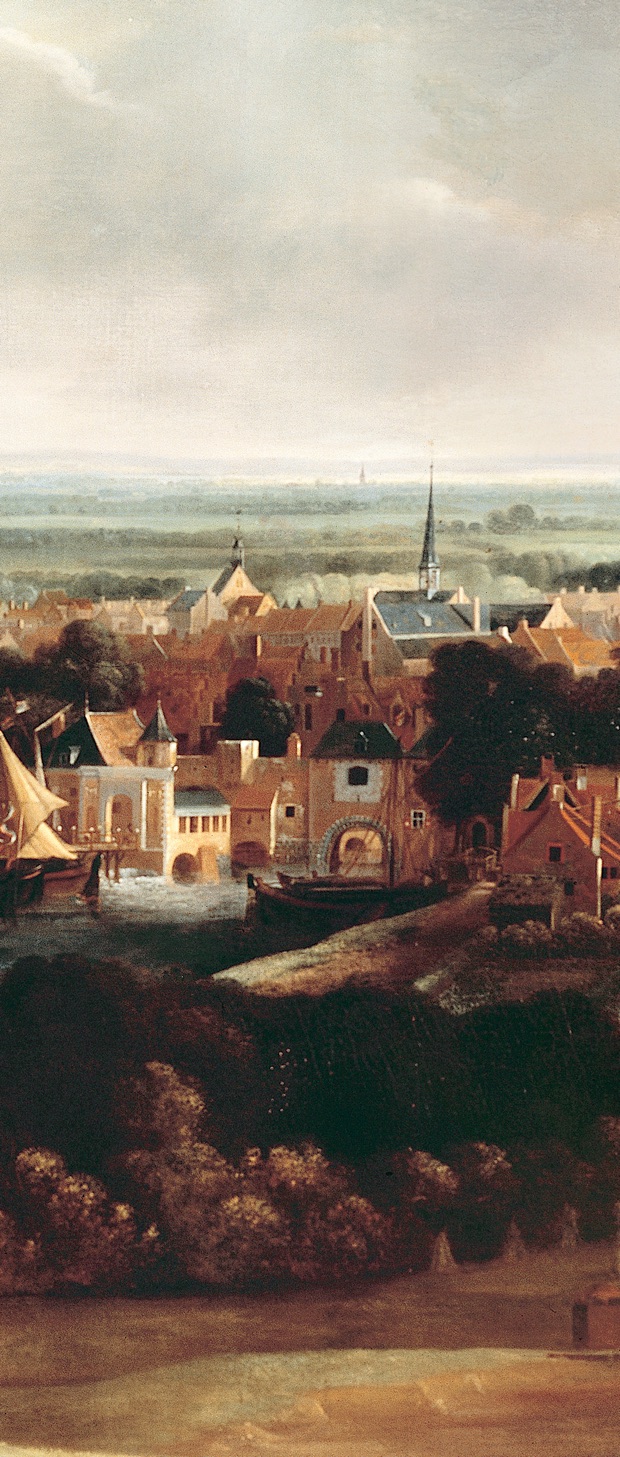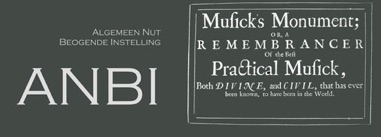MATTHIAS WITHOOS (1627-1703) AMERSFOORT 1671
GABRIEL FAURE - AVE MARIA - (MOVIE - MARIA & THE MIRACLE OF AMERSFOORT 1444)
PAULA BAR-GIESE SOPRANO
FRANCIS EVERS - MEZZO SOPRANO
HEIN HOF - ORGAN ST MARTINUSKERK HOOGLAND

Withoos was a Dutch still life and cityscape painter, best-known for the details of insects, reptiles and undergrowth in the foreground of his pictures.
Withoos studied under Jacob van Campen, at his painters' school just outside the city at his country house, and then with Otto Marseus van Schrieck. When he was 21, Withoos made a trip to Rome with Van Schrieck, and Willem van Aelst. There they joined the group of northern artists known as the "Bentvueghels" ("Birds of a feather"), and Withoos went by the alias "Calzetta Bianca" ("White Hose")—a translation of his name into Italian. Withoos' work caught the eye of the cardinal Leopoldo de Medici, who commissioned various paintings from him. By 1653 Withoos had returned to Amersfoort, but when the French troops occupied the town in during in the "Disastrous Year" of 1672, Withoos fled to Hoorn, where he would remain until his death in 1703.
Withoos is best known for his still-lifes. These often depict the base of a tree trunk with a longer view of a sand-dune or hilly landscape and show small animals, reptiles and insects among thistles and other plants. The plants and wildlife are painstakingly depicted, often in strongly differentiated areas of light and shade. Some of his works, such as the Vanitas in a Graveyard (Stockholm, Eric Vaaeur, Private Collection), which shows a ruined graveyard with a pyramid and Classical urns, have vanitas connotations. In the foreground is an arrangement of vanitas symbols such as skulls, a globe, a book and an hour-glass. Withoos used cool colours, which contributes to the mysterious atmosphere and recalls the sfumato technique of 16th-century Venetians. The painting is probably indebted to Salvator Rosa’s Democritus (Copenhagen, Statens Museum for Kunst), which was exhibited in the Pantheon in Rome in 1651 and known either directly, or through a print, by Withoos. Withoos also painted views of Dutch ports (e.g. Grashaven near Hoorn, 1675; Amsterdam, Rijksmuseum).
Five of Matthias Withoos’s children were also painters: Johannes Withoos (b Amersfoort, 1648; d Hoorn, 1685) painted landscapes; Pieter Withoos (b Amersfoort, 1654; d Amsterdam, 1693) and Frans Withoos (b Amersfoort, 1657; d Hoorn, 1705) specialized in watercolours of insects and flowers; Alida Withoos (b Amersfoort, 1659 or 1660; d Hoorn, after 1715) painted still-lifes and landscapes; Maria Withoos was principally a watercolour painter.
Collections
Withoos is represented in the following collections: Rijksmuseum, Amsterdam; Statens Museum for Kunst, Copenhagen, amongst others.

The miraculous discovery of a statue of the Virgin and Child (MOVIE) when in 1444, a young woman Geertgen Arents from Nykercken came to the town of Amersfoort to enter the Agnieten-Convent. Before passing through the town gate [Camp poort], she took a plain figurine of the Virgin and Child from her belongings and threw it in the water, because she was embarrassed to show the humble work to the sisters at the convent. A few weeks later, another woman, Griet Albert Ghisen, had three successive visions in which she was instructed to go to the canal by the town gate to rescue the Virgin Mary from the water. When she arrived there, the woman saw the discarded figurine lying under the ice which covered the flowing water. She fished it out and took it home with her. After she had told her story to the priest, the statue was taken to the Church of Our Lady of Amersfoort. Subsequently, various miracles attracted numerous pilgrims. Unfortunately, little is left of the miraculous figurine, making it difficult to describe or date it accurately. From what remains one can deduce that it was a very simple statue made of pipe clay.
A c.1525 panel painting, made for the church of Our Lady in Amersfoort, shows the miraculous discovery of the statuette in 1444, but the painter added a church tower, which was not finished until 1470, financed by the pilgrimage revenues.
Uit de Agnietenkroniek:
In den jare ons Heeren 1444 geschiede in de stadt van Amersfoordt een wonderlick mirakel. Alse dat eenre eerbaer vroupersoon, genaempt Griet Albert Ghisen, die Godt ende sijnre gebenedider moeder trouwelicken diende, deese werde drije mael van ons L. Vrouwe vermaent omtrent Kersmisse, dat sij haestelick soude gaen aen stads graft buijten de poort [Camp-poort], daer ‘t water hard bevrosen was, omdaer wt te trecken ons L. Vrouwen beelde, dat onder dat ijs was verborgen, ‘twelck met de stroom nijet wech en dreeff, nochte oock nijet te gronde en ginck, maer in dat lopende water bleef stil ende onbeweechlick staen. Deese Griet vertelde dit haren heer off meister dijen sy diende [Dese woonde int laeste huijs aan de Camppoort ende was genaempt Jan Huberts die verwer], om te horen wat hij haer riedt. Hij hieldet voor een ijdelen droom, belachte haer ende vermaende se, dat se daer van swygen soude. Nochtans doen sy derde werft vermaent was ende dorste zij niet langer vertrecken, maer sy stont wackerlick op ende met betrouwen ensde innicheijd ginck sij derwaerts ende in dier stede, daer men water putte, daer vant sij ‘t voorseijde Marienbeeld. [Griet Albert Gysen was geboren in de Duijst anno 1395 ende storff annno 1493, oudt 98 jaren]. Sij brack dat ijs ende buijchde oodmoedelick haar knijen ende nam dat beeld met alder oodtmoedicheyd wtten lopende water ende brachtet thuijs, daer hem van verwonderden alle die daer omtrent woonden. Ende sij settent in huijs op een tresoir en ontstack een keersse, die sy daervoor sette brandende, die wel drije mael langer brande alse gedaen soude hebben. Dit vertelde sij haer biechtvader, die seijde, dat sij het beeld t’sijnen huijse soude brengen, gelijck sij dede op Kerstavont, in welcken huijse oock des selven nachts ende des anderen daechs merckelicke mirakelen geschied sijn. De biechtvader was genoempt broeder Jan van Schoonhoven, Carmelyt. Deese biechtvader dit aenmerckende, nam dit beelde met eerwaerdichheijd ende brachtet oodmoedelick in ons L. Vrouwen kercke op St Stevens dach, op een Saterdach, daer van naebij en van verre veel personen in pilgrimagie sijn gecomen ende veel mirakelen geschiedt.
In den voors. jare 1444 quam eene Geertgen Arents van der Nykercken tot Amersfoort in den convente van St Agnieten om suster te worden ende blyven. Ende doe sy onderweegen was, dacht sij, wat sij doen soude met dat cleijn simpel beeldeken van ons L. Vrouwe, ‘twelck sij hadde onder haer cleinitten, die sij met haer bracht. Ende doe sij bij de Camppoort quam, dacht zij, dattet schande was, dat sij sodanich beeldeken in ‘t clooster soude bringen ende de ’susteren laten sijen. Ende met onbedachtichheydt werp sij ‘tselve beeldeken in de waterbeeck, daar het corts daer nae in gevonden worde. Want doen sij hoorde d’veele groote mirakelen, die in ons L. Vrouwen ofte St Joosten capel geschieden door een sodanigen beelde, die van sulcken forme ende maecksel was ende in de voors. stede gevonden, soo plach sij dat oodmoedelick te belijen, dattet ‘tselven beelde was, ‘twelck sij soo onberadelick ende onwijselick in ‘t water geworpen hadde.
In den jare 1445 openbaerde ons L. Vrouwe aen suster Geertruyd Willems, oude procuratrix van d’voors. convente, als dat tot haerder eere, vermits veel pelgromsgiften, offerhande ende devotien, men een hoogen schoonen toorn soude timmeren.
Eén van de manieren waarop men het verhaal van de wonderbaarlijke vondst verspreidde, was in dichtvorm. Aangezien veel mensen nauwelijks konden lezen of schrijven, was dit de beste manier om informatie over te dragen. Gedichten konden makkelijker onthouden en voorgedragen worden dan proza.



